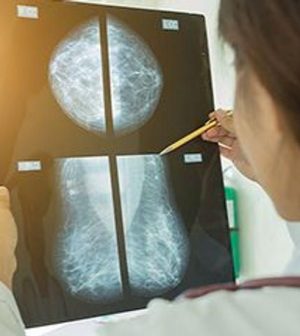- Skip Storing This Everyday Product in the Fridge Door
- Green Tea + B3 Pairing May Boost Brain Health
- Navigating Your Midlife Crisis: Embracing New Possibilities
- City Raccoons Showing Signs of Domestication
- Mapping the Exposome: Science Broadens Focus to Environmental Disease Triggers
- One Week Less on Social Media Linked to Better Mental Health
- Your Brain Changes in Stages as You Age, Study Finds
- Some Suicide Victims Show No Typical Warning Signs, Study Finds
- ByHeart Formula Faces Lawsuits After Babies Sickened With Botulism
- Switch to Vegan Diet Could Cut Your Greenhouse Gas Emissions in Half
Mammography Rates Plummeted During Pandemic

There was a sharp drop in mammography breast cancer screening during the COVID-19 pandemic, and the decline was especially severe among American women of color and those living in rural areas, new research shows.
Those trends could cost lives in years to come, because “detecting breast cancer at an early stage dramatically increases the chances that treatment will be successful,” said study lead author Ofer Amram. He’s an assistant professor of medicine at Washington State University’s Elson S. Floyd College of Medicine in Spokane.
One breast cancer expert who wasn’t connected to the study agreed.
“The pandemic significantly reduced the frequency of breast cancer screening, which will likely lead to an increase in breast cancer mortality,” warned Dr. Paul Baron, chief of breast surgery at Lenox Hill Hospital in New York City.
“Every effort should be made to reach those who did not have their mammograms in 2020,” he said.
In the study, Amram’s group compared the number of screening mammograms at MultiCare, a not-for-profit health care system in Washington state, between April and December of 2019 and then again during the same months in 2020.
They found a big drop: The number of completed screenings fell by almost half, from almost 56,000 in 2019 to around 27,500 in 2020.
Declines in screenings were even greater among Hispanic women (a 64% decline) and American Indian and Alaska Native women (61%) compared to white women (49%). Rates also fell by 59% among rural women compared with 50% among urban women.
The researchers also found that women who were covered by Medicaid and those who had to pay for screening out of pocket had greater declines in screening than those with commercial or government-run insurance programs.
“Health care providers need to double down on efforts to maintain prevention services and reach out to these underserved populations, who faced considerable health disparities even before the pandemic,” Amram said in a university news release.
“The common thread in these groups is that they consist of a larger percentage of patients who may be unable to undergo routine cancer screening due to time demands at work or child care responsibilities at home from school closures,” Baron noted.
“In addition, the financial consequences of the pandemic — such as lost jobs or pay cuts — may have had a significant impact on their ability to afford mammograms, copays, deductibles or even transportation to the imaging facility for routine mammograms,” he said.
All of this is already impacting the health and cancer prognosis of women being screened now, Baron warned.
“Over the past few months, many of us who treat breast cancer often see patients who first found a breast mass before April 2020 and are showing up now, frequently more than a year later, for evaluation of what turns out to be a cancer that is advanced due to delays in seeking health care,” Baron said.
Dr. Nina Vincoff is chief of breast imaging at Northwell Health in Lake Success, N.Y. Reading over the new study, she agreed that “we are only beginning to understand the full impact of the COVID 19 pandemic on preventive health care, and the disproportionate toll it has taken on certain communities.
“These results should be a call to action for community outreach,” Vincoff said. “We need to provide education and assistance to populations at risk so that they resume screening and wellness health visits. Otherwise, we can expect these groups to come to medical attention with diseases like breast cancer when they are more advanced and harder to treat.”
The study was published May 24 in the journal JAMA Network Open.
More information
The U.S. National Cancer Institute has more on mammograms.
SOURCES: Paul Baron, MD, chief, breast surgery, Lenox Hill Hospital, New York City; Nina S. Vincoff, MD, division chief, breast imaging, Northwell Health, Lake Success, N.Y; Washington State University, news release, May 24, 2021
Source: HealthDay
Copyright © 2025 HealthDay. All rights reserved.










